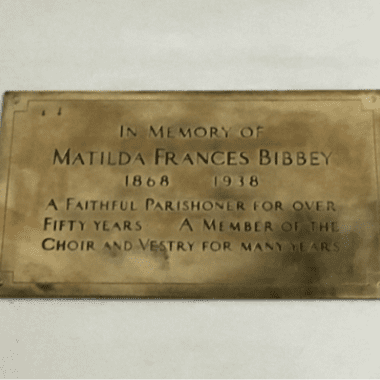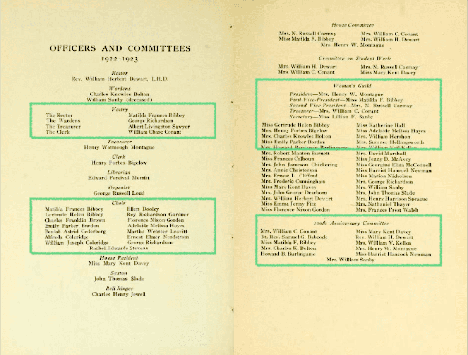The People in the Pews: Matilda Bibbey, the First Woman of the Vestry

In the rear of the church, there is a modest plaque honoring Matilda F. Bibbey. It is the only plaque in Old North solely dedicated to a woman.
Matilda Frances Bibbey was born in the North End in 1868. Her mother, like many other North End residents at the time, was an Irish migrant. Her father, Thomas, had migrated to Boston from England via New Orleans, and worked as a rigger across the harbour in the Charlestown Navy Yard. The family lived in a row of nine houses on the now defunct Vernon Place, off of Charter Street. Mirroring the North End migration patterns, the Bibbeys moved to Dorchester in the 1890s, but Matilda very much remained part of the North End community.
In the first two decades of the twentieth century, Matilda worked at a girls’ school on Parmenter Street, opposite what is now the North End branch of the Boston Public Library, and mere blocks from the church and her childhood home. Matilda’s work as a teacher would have been made more difficult by the changing populations with whom she worked and the crowded classrooms. By this time, the Irish neighbors of Matilda’s childhood had moved out of the North End and migrants from Italy and Eastern Europe were moving in. Presumably, many of their children, Matilda’s students, were English Language Learners with few in-school supports systems. (In the stark reality of 2020, it would be remiss not to mention that her time at the Parmenter Street school also intersected with the 1918/19 Spanish Flu Pandemic and at a time when the North End was one of the most crowded neighborhoods in the world.) Matilda worked in public schools until retiring at the age of 70 in 1938; two months before her passing. Matilda also spent her summers working with young people. For three decades she was the House Mother at the Girls’ Friendly Society Holiday House in New Hampshire.
It’s not clear when the Bibbeys started going to Old North, or Christ Church as they would have called it. However, as adults, Matilda and her sister Gertrude were both very active in the church. They sang in the choir and were founding members of the Women’s Guild in 1915. They also owned their own pews; Matilda’s was at ground level, pew 16. Why did two single women need their own pews? Perhaps they attended church with their siblings and nephews with whom they lived. Notably, their brother John was not the pew owner nor was he the head of household on the census. This role belonged to their sister, Mary.
Arguably Matilda’s most impressive involvement at Old North is as the first woman of the vestry. She took on the role in 1911 and more than a decade later in 1923 remained the only woman in the vestry; indeed, she was still listed under the heading Vestry Men.
There is no doubt that Matilda was a valued and well-reputed member of her communities. Her death notice appeared in the Boston Globe as did news of services and dedications in her honor, including the plaque erected in the church. However, these accolades have not withstood the test of time, and Matilda is absent from the enduring histories of Old North, the North End, and Boston, unlike those such as her fellow vestryman, Hugh Ogden. Matilda’s story is pulled from the historic pages of the Boston Globe, Old North’s archives, and other public records but absent is her own voice and a photograph. This leaves many unanswered questions about her reflections and perspective of her day-to-day experiences and the large global events of the time including the First World War, the Spanish Flu Pandemic, and the Women’s Suffrage Movement.
Irrespective of Matilda’s engagement with or opinions on women’s suffrage, she enacted a feminist resistance of her own. Her visible roles in schools, the church, and as community leader, along with her public recognition in the pages of the Globe showed young girls what they could be. Her acts of defiance, intentional or unintentional, slowly but persistently contributed to the normalization of working women and women as community leaders that women benefit from today. Matilda’s story and actions can inspire all of us to reflect upon our own subtle acts that maintain the status quo or enact change, acts that help or hinder the formation of the future to which we aspire.
Jodie Smith is an Independent Museum Professional with 15 years’ experience in school-aged history education. Most recently, she worked with students at Somerville High School to curate an exhibit at the Somerville Museum. She also does archival research projects some of which have been published online as well as in history and education magazines, and mainstream newspapers.
Images
1. Plaque at the rear of the church. Photo by Jodie Smith.
2. Bolton, Charles Knowles. “Christ Church, Salem Street, Boston. 1723. A Guide. 200th Anniversary Edition. Christ Church Boston, 1923.
References
Bolton, Charles Knowles. “Christ Church, Salem Street, Boston. 1723. A Guide. 200th Anniversary Edition. Christ Church Boston, 1923. Accessed 15 January 2019. https://archive.org/details/christchurchsale1961bolt/page/n71
Boston School Committee. “Annual Report of the School Committee of the City of Boston 1905.” Municipal Printing Office, 1905. p.244. Google Books. Access 4 February 2019. https://books.google.com/books?id=m72gAAAAMAAJ&printsec=frontcover#v=onepage&q=bibbey&f=false
“Girls’ Friendly Society Dedicates a Tablet.” Daily Boston Globe (1928-1960), 2 September 1939. ProQuest Historical Newspapers: The Boston Globe, pg.13. Accessed online 31 January 2019.
“Religion in Greater Boston: What the Churches of the City Offer You.” Daily Boston Globe (1928-1960), 7 January 1939, ProQuest Historical Newspapers: The Boston Globe, pg. 11. Accessed online 31 January 2019.
“Tenth Census of the United States.” Boston, Suffolk, Massachusetts, 1880. Roll. 552, p.326B. Ancestry. Accessed 15 January 2019.
“Women’s Guild Minutes 1915-1921. Old North Church (Christ Church in the City of Boston) records, Massachusetts Historical Society. Box 41, Folder 19.

